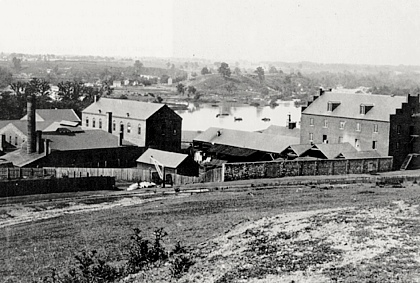Civil War: Aftermath of the Explosion
After the massive explosion on Brown’s Island in March of 1863, Richmond was in mourning.

In the latter half of March 1863, Richmond was in mourning. The tragic loss of over 50 lives in the explosion at the C.S. Laboratory on Brown’s Island weighed heavily on the city. In the days following the March 13th incident, the newspapers reported a rising body count as more bodies were discovered and more victims succumbed to their wounds.
Mary Ryan, the 18-year-old girl whose actions ignited the explosion, amazingly survived the initial blast only to die a week later from her injuries:
Died of Her Injuries. – Mary Ryan, the young girl in whose hands exploded the friction cannon primer, causing the terrible disaster at the Government Laboratory, died of her injuries at her father’s house, on Oregon Hill, on Monday. One or two others are reported as having expired since Sunday. Richmond Sentinel, 3/18/1863</cite.
Many more would be reported dead in the weeks following the explosion. Bodies continued to be discovered even a month later; one of the last undiscovered victims, Martha A. Burley, was found in the river after she drowned trying to extinguish the flames on her clothing. In the days following the incident, there were so many funerals that the processions would pass each other on the street on the way to Richmond’s cemeteries. Many were buried at Hollywood Cemetery while others were interred at Shockoe and Oakwood Cemeteries.
Richmond quickly rallied to show support for the injured and the families of the victims. The city’s mayor, Joseph Mayo, created a committee to solicit contributions and also asked the Young Men’s Christian Association (YMCA) for aid. Many in Richmond contributed despite the tough economic conditions they faced. Similarly, soldiers in the field mailed donations back to Richmond when they heard of the accident. According to the Richmond Sentinel, one soldier wrote, “A non-resident of the city, I beg appeal to all humane people in the city and the State, to contribute to so laudable a purpose. The poor wounded creatures are young females who were dependent on their daily labor for their support. I send you five dollars and am only sorry I cannot afford more.”
Others in the city put on fundraising events:
Benefit for the Laboratory Sufferers. – Some young gentlemen of this city will give a ball to-night at the Market Hall for the benefit of the unfortunate sufferers by the explosion on Brown’s Island. They anticipate a pleasant entertainment, and hope to see those who are fond of the dance, promising to do all in their power to give enjoyment, and at the same time relieve those who were injured by the late accident. (Richmond Sentinel, 3/26/1863)
Despite the outpouring of public support following the incident, awareness of the Brown’s Island explosion has faded significantly since it happened 150 years ago. I admit as a history buff, my perception of Richmonders’ Civil War knowledge is probably a bit skewed, but it seems that other events like the Richmond theatre fire of 1811 (commemorated by the Monumental Church on Broad St.) are better known by the general public.
I’d love to hear from readers: was the Brown’s Island explosion something you’d heard of before?
Next time you head down to the river to enjoy the beautiful outdoor space or take in one of the Friday Cheers concerts, take a moment to think about both Brown’s Island and Belle Island (former Union prison camp) and their hidden (and somewhat morbid) histories.
-
Recommend this
on Facebook -

Report an error
-

Subscribe to our
Weekly Digest




There are 10 reader comments. Read them.